CHICAGO – In anticipation of the scariest week of the year, HollywoodChicago.com launches its 2024 Movie Gifts series, which will suggest DVDs and collections for holiday giving.
HollywoodChicago.com’s Top 10 Films of 2009
CHICAGO – They came, we saw and in the end, who conquered? HollywoodChicago.com Senior Writer Patrick McDonald weighs in on the Top Ten of 2009. From the rich palette of choices, the challenge is always to winnow it down to ten.
This was a strong year, with many films in the “eleven spot” that would qualify easily for Top Ten consideration in any other year, including “An Education,” “Fantastic Mr. Fox,” “Inglourious Basterds,” “The Hurt Locker,” “Red Cliff,” “Precious” and “Capitalism: A Love Story.”
But as the old saying goes, opinions are like a certain hole, everybody has one. Here is Patrick McDonald’s journey into that deep void…
 10. ‘Star Trek’
10. ‘Star Trek’
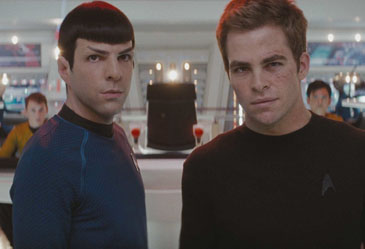 Photo credit: © 2009 Paramount Pictures |
Yep, a true popcorn film makes the cut. One that beat the odds and expectations of Trekker geeks everywhere. What impressed most about this origin re-imagining of this storied franchise was the care to detail and casting. The production, headed by the sure direction of J.J. Abrams and scribing of Roberto Orci/Alex Kurtzman, was a respectful combination of the rich story traditions that made Star Trek famous and the current mania for realistic computer generated space.
The portrayals of the legendary characters were spot on, with a particular nod going to Karl Urban, who was channeling his inner Dr. McCoy/DeForest Kelley. And even more fun, did Leonard Nimoy seem like he was in another film? It must be said (unfortunately), live long and prosper.
HIGHLIGHT: Kirk [on Spock]: Who is that pointy-eared bastard? Bones: I don’t know, but I like him.
 9. ‘Bright Star’
9. ‘Bright Star’
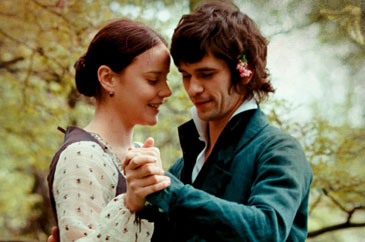 Photo credit: © 2009 Apparition |
There is something about creating language that is more than just a communication, as practiced in this film by John Keats, the noted British romantic poet. Bright Star is a languidly paced costume drama that is expressly enhanced by Keats’ incredible poems. The legendary writer/director Jane Campion seemed born to render this story, and was aided by the florid performances of Ben Whishaw (Keats), Abbie Cornish (as Fanny, his lover) and Paul Schneider (as Keat’s friend and facilitator).
The tragedy of John Keats is handled as a contemporary reality of his times, not as some “Love Story” disease-of-the-month. It is both a social economic history lesson and a literary lightning bolt, astutely realized.
HIGHLIGHT: Promoting atmospheric phrases like “A thing of beauty is a joy forever; it’s loveliness increases; it will never pass into nothingness.”
 8. ‘A Serious Man’
8. ‘A Serious Man’
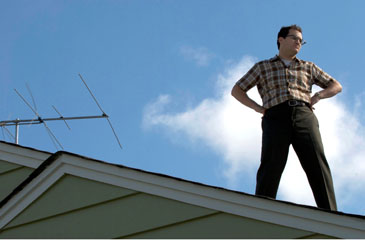 Photo credit: © Focus Features |
Joel and Ethan Coen, master auteurs, get personal with this dark comedy about the mendacity of life in late 1960s America. Michael Stuhlbarg contemplates his inner mensch as Larry Gopnik, an academic who is suddenly overwhelmed with a number of faith challenging circumstances. There is a particular nature about the proceedings that seem familiar to everyone in the human condition, and the fact that it is filtered through memories of the Coen Brothers religious heritage adds a piquancy that invites commonality.
Highly symbolic and archly hilarious, this piece is an accessible film study dissertation, made even more palatable by a voyeuristic nude scene. Another gem in the Coen canon.
HIGHLIGHT: The inability to unlock a door in the end.
 7. ‘The Men Who Stare at Goats’
7. ‘The Men Who Stare at Goats’
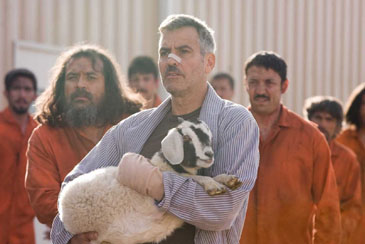 Photo credit: © 2009 Westgate Films |
A broad military farce, coming off the heels of 2008’s parade-of-serious-Iraq-dramas (continued this year with “The Hurt Locker” and “Brothers”) was welcome relief. Clooney plays an indispensable straight man as an army specialist who has come from an ultra-secret unit. Nobody in the excellent cast blinks as they run through absurdity after absurdity, within a post-Vietnam context that mirrors real life more often than not. Even in this year of “Crazy Heart,” Jeff Bridges gives his best performance in this film.
It is heartening in this era of support-the-troops-or-else, that there still can be room for a little boat rocking, which proves that celluloid projection can also be mightier than the rocket launcher.
HIGHLIGHT: Any appearance of an actual goat.
 6. ‘A Single Man’
6. ‘A Single Man’
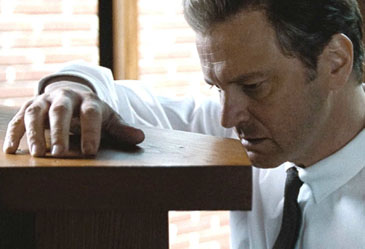 Photo credit: © 2009 Eduard Grau for The Weinstein Company |
Grief and mourning after a death – and the subsequent emotional exhibition – is elusive as narrative, especially in a 90 minute film. A Single Man does an extraordinary job with the grieving journey of George (Colin Firth), a gay British literature professor at a California university in 1962. When his lover of 16 years is killed unexpectedly in an automobile accident, he must come to terms with his newly solitary life in a 24 hour period (without an invitation to the funeral in the closeted era).
First time director Tom Ford (a noted fashion designer) brings heart and style to this highly claustrophobic story, with strong performance support by Julianne Moore as George’s socialite best friend. But it is Firth who shoulders the heavy yoke of the tragic realignment, in a career defining rendition.
HIGHLIGHT: A historical perspective on pre-Stonewall gay life.
 5. ‘District 9’
5. ‘District 9’
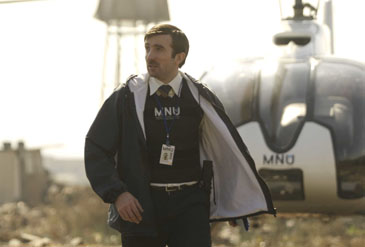 Photo credit: © 2009 Columbia Tri-Star |
Beyond the direct references to apartheid and immigration, District 9 is a relationship story, and never loses the meaning of that thread throughout. Extra-terrestrial creatures invade Johannesburg, South Africa, and stick around long enough to cause a backlash. When a feckless government official (Sharlo Copley) is asked to clear an alien settlement, the subsequent breakdown of the society has implications for all. Newcomer writer/director Neil Blomkamp puts a gritty facade in imagining such a scenario, but never forgets the connections, human or otherwise.
The faux documentary style does a good job of creating as many questions as it answers, which anticipates either a prequel or sequel, whatever works.
HIGHLIGHT: Never rang false, simply by highlighting our own prejudices.
 4. ‘The White Ribbon’
4. ‘The White Ribbon’
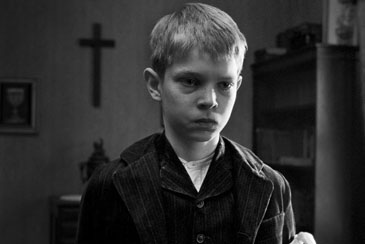 Photo credit: © 2009 Sony Classics |
Director/writer Michael Haneke, with his skewed and affecting view of the world, is becoming more influential with each new notch in his filmography. The White Ribbon is a stark and challenging narrative about forces seen and unseen. When a pre-WW1 Austrian village is broken by a series of tragic events, the societal structure that supports a land baron arrangement is shaken to its core. Religion, politics and class are burned at the stake, only to be “rescued” by the coming world war.
Haneke, as he has done in previous films like “Cache,” establishes a mystery within that parrots a certain reality, where what is plainly evident is not always what is actually happening. He is a master illusionist with filmmaker’s tools.
HIGHLIGHT: The naturalistic cast is retroactively appropriate for the era they are representing.
 3. ‘In the Loop’
3. ‘In the Loop’
 Photo credit: © Nicola Dove for IFC Films |
As critics used to say about the films of director Billy Wilder, absorbing them is like biting into an arsenic cookie. In the Loop has a similar flavor, laced with nightshade. Hilarious and frightening because it’s all so true, the game of cover-thy-ass is perfectly illustrated in a British/America alliance to fudge “intelligence” to justify Mideast War. The political level that it exposes is extremely distressing, between the bouts of Wilder-like black humor, albeit more relentlessly foul mouthed.
The cast is like a superior symphony orchestra, generating the cues off each other and making extraordinary music as directed by Armando Iannucci, with a revelatory script from Jesse Armstrong.
HIGHLIGHT: The tornado-like character presence of Malcolm Tucker, played by Peter Capaldi.
 2. ‘Where the Wild Things Are’
2. ‘Where the Wild Things Are’
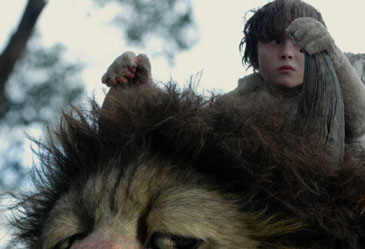 Photo credit: © Warner Bros. Pictures |
”Where is the fancy bread, in the heart or in the head?” The film version of the classic children’s book Where the Wild Things Are completely alters that pointed question, under the radical vision of director Spike Jonze. A young, uncontrollable boy (Max Records) takes a journey to his own psyche, populated by the monsters of his inner emotions. Part live action cartoon, part morality play, it somehow meshes sweetly and concludes its heroics in a compact 101 minute fable. Although at times murky, it never fails to excite the senses and create the beauty from the truth.
In creating such a imaginative world, Jonze relies more on his voice actors (like James Gandofini) to bring the savory life to the Maurice Sendak creatures over and above the special effects. It is the human nature that drives this monstrously entertaining instant classic.
HIGHLIGHT: Scenic design that is awe inducing.
 The Big 1. ‘(Untitled)’
The Big 1. ‘(Untitled)’
 Photo credit: © Samuel Goldwyn Films |
Why is a low budget independent film, completely under the radar, the number one film of 2009? Because it dares to be a mature and complete film, about the perspective of art that resides in each of us. The scenario is represented by a composer of atonal symphonies (Adam Goldberg), his disrespected artist brother (Eion Bailey) and a gallery owner (Marley Shelton) who refuses to compromise her veiled intuition.
This triptych of searchers meander through the gallery trends and pretenders, trying to find the elusive answer to “What is art?” In the end the film satisfyingly seems to have an answer, but at the same time what is it?
HIGHLIGHT: A script that is like literature, co-written by director Jonathan Parker and Catherine DiNapoli.
 | By PATRICK McDONALD |



Well, I think this is a nice
I think this is a nice movie.